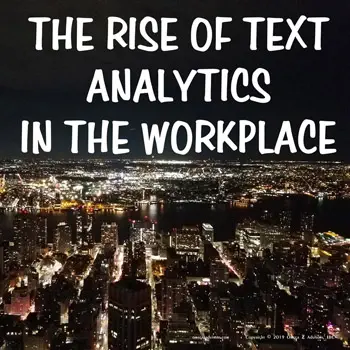Warning To Employees Regarding Future Of Text Analytics At Work
The words people choose say more than just the message they state. What they say beyond that message falls in the realm of text analytics. The future of text analytics at work involves employees. It could determine a promotion, a raise or a termination.
Text Analytics Example
Consider this example. Two employees state their thoughts in emails regarding a process they’re using:
Employee A
I like this process because its steps state clearly what you have to do. There’s no guesswork. You just do what it says, no thinking.
Employee B
I like this process because there’s a lot of flexibility. It gives many options. It’s easy to do what you think you need to do to get the job done.

Now, here’s the question: Which employee do you think is more likely to break company rules? That’s text analytics.
Keep in mind that while the answer might be Employee B. It’s not certain. We would need more sample text. However, the amount a human needs is far less than artificial intelligence would. It’s like image recognition. A child knows a hot dog after seeing it two or three times. AI needs to see it at least a million times.
Future of Text Analytics At Work
Some companies are already using text analytics to assess employee morale. Firms are already finding that this is better than employee surveys.
Most people are familiar though with text analytics in assessing personalities. For instance, who’s likely more aggressive, the person who says, “We should kill this project,” or the one who says, “We should end this project”? It’s the same message, but not the same thing.
This can lead firms to conclude who might be good for a project, for management or for termination. Of course, firms will say they do this to help employees. That’s true. This can. Text analytics can advise managers on coaching strategies for employees.
Warning To Employees
Remember though. The tool does not make the person. The person makes the tool. If he has good intentions the tool will do good things. If she does not, it won’t.
Thus, the warning to employees about the future of text analytics at work is learning to choose good words. What do they say about you? It’s not just avoiding slang or curses. It’s also the difference between “connections” and “relationships.” It’s also understanding the culture one’s in.
As one tech savvy employee who focuses on security and privacy issues for a research firm said, “I avoid company email and texting as much as possible. Speaking directly to colleagues is safer.”
Yes, it’s an extreme. Yet, it’s a warning. Employees need to take greater care how they write at work. It says more about them than they know.


